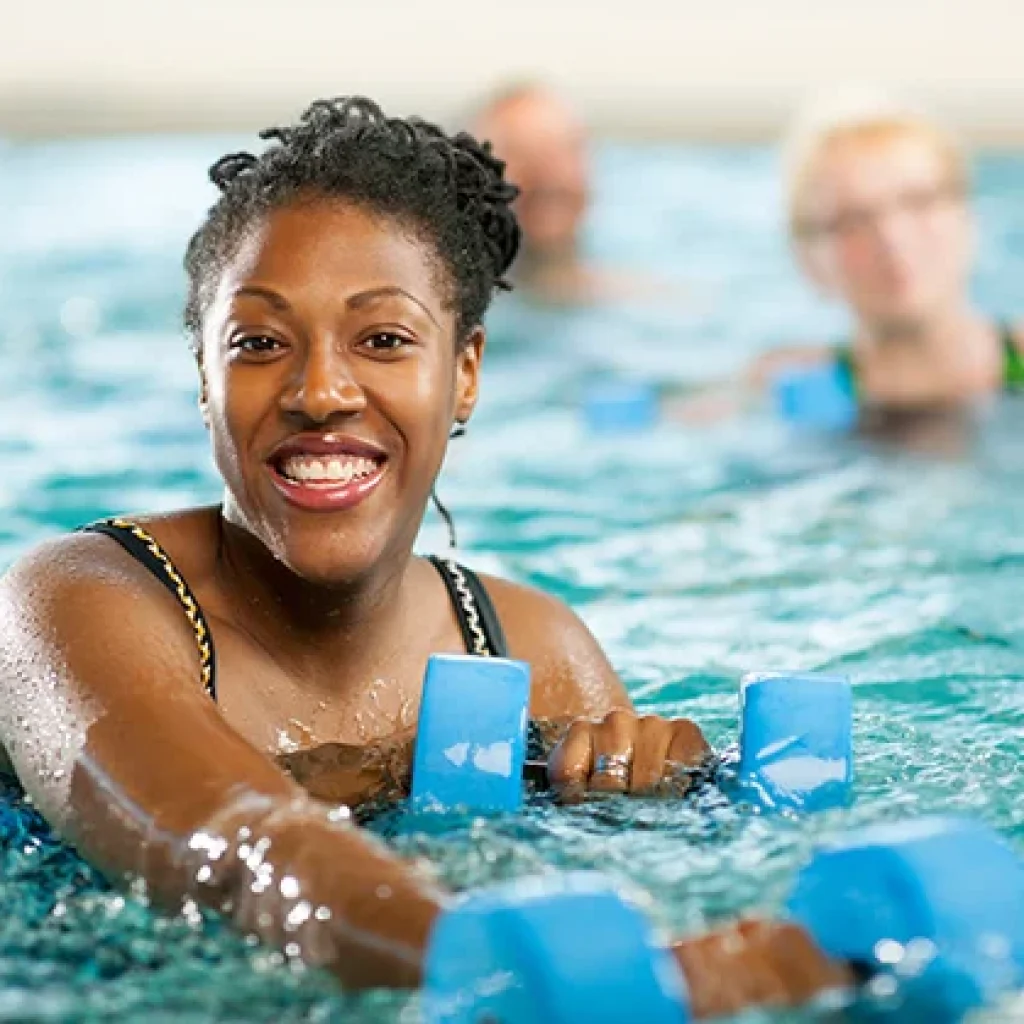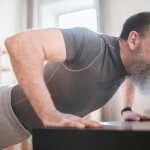Standing in the waters of Georgian Bay by my home in Collingwood Ontario, I am overtaken by sensations of peace and wonder.
My breathing is calm, and I think of nothing other than my skin rejoicing as I move through the silky-smooth cold water. I shiver in delight as I sink into the freshness up to my shoulders – the hardest part!
As I scan the never-ending sky of this ocean-like bay that I’ve been intimate with since I was a child, I feel at home, refreshed, renewed, and awakened.
My mother, who is 81 and healthier than most 55-year-olds, swears that her regular cold-water swims in the bay keep her healthy. Somehow, I believe her.
Many people eschew the vagaries of natural bodies of water and prefer to swim in pools. Pools can also be a wonderful opportunity to get some sustained exercise as well as social connection.
And while many of us can go on and on about why we love swimming, there’s a good explanation as to why that is.
Why Humans Love Swimming

Whether or not you believe that at one point, humans had gills and crawled out of the ocean (Man From Atlantis anyone?) the reality is while we are in the womb, we breathe through the incredible placenta as we float around in amniotic fluid.
Once out of the womb, our adult bodies average around 60% water. We can go without food for weeks but can only go a few days without water before dying of dehydration.
Humanity’s most ancient ancestors had to find water to survive. Whether it be for a source of food or drinking water, or both, this led to adaptations in humans that make swimming a natural inclination for many people.
While most of us aren’t as naturally gifted in water as Michael Phelps, our streamlined body shape, ability to hold our breath, and natural buoyancy in water enables us to move efficiently and somewhat comfortably in aquatic environments.
A Full-body, Cooling Workout
Swimming is a great form of exercise that provides a full-body workout and can cool you down at the same time. It engages almost all your muscle groups, improves cardiovascular fitness, enhances flexibility, and increases endurance.
Swimming can help you maintain a healthy weight, strengthen muscles, improve lung capacity, and promote overall fitness and well-being. Plus, regular swimming will help you look great in your bathing suit no matter what time of year.
The sensation of water against the skin can be invigorating and revitalizing and the feeling of weightlessness can also be mentally and emotionally relaxing.
Physical and Mental Rehab

Water’s buoyancy reduces the impact of gravity on the body. Swimming puts less weight on joints and can be especially therapeutic for individuals with joint pain, injuries, or conditions like arthritis.
The motion of swimming and the need for regular, sustained breath work can have a meditative quality that can help reduce stress and promote relaxation.
Swimming can be a form of mindfulness and an opportunity for introspection.
Whether you love to swim laps, swim across a lake, play water sports, skinny dip at night, or simply splash around, swimming offers a sense of joy, freedom, and fun for all ages.
It can be an opportunity for increased fitness, a social activity, a way to bond with friends and family, or an opportunity for personal enjoyment and self-expression.
High-Intensity Water Exercise

One thing swimming doesn’t do well is promote bone density. Swimming places little stress on the skeleton, and bones require mechanical stress to encourage bone formation.
The result is that people who are mainly swimmers need to do a bit more weight-bearing exercise to make sure their bones stay strong as they age.
The one caveat to this long-held assumption is High Intensity Interval Training (HIIT) in water. In 2018, Aboarrage and colleagues trained study participants in a high-intensity aquatic exercise regime that included a form of interval training using jumping and hopping performed for 20 minutes in warm water that was about chest deep.
By using exercise that encouraged jumping in water and high exertion, the water exercisers increased bone density throughout the body, and specifically in the spine and femur. The exercise group also had greater leg strength and agility after the six-month time frame than the controls.
So, while swimming itself may not have benefits for bone density, you can leverage the increased resistance of the water in exercises to promote bone density.
Learning to Swim as an Adult
Depending on where you grew up, you may not have learned to swim as a child. Many people learn to swim through community organizations. If you do not know how to swim, find a local pool with adult swimming lessons to get you going.
Make sure you only swim with a lifeguard present until you are a proficient swimmer.
Watch the video below for some helpful tips.
These factors contribute to the enduring appeal of swimming for many people. However, it’s important to note that personal preferences, cultural influences, and individual experiences can also shape one’s attraction to swimming.
Not everyone shares the same level of interest or comfort in the water, and individual abilities and confidence can vary.
If you do take to the water, safety first and don’t forget sunscreen if you’re swimming outside.
~ Read more from The Health Insider ~
- The Best Fitness Tech Under $100
 🎁 Perfect for the wellness enthusiast on your list who loves practical, budget-friendly fitness finds. These 5 budget-friendly health tools are all under $100, deliver tracking, recovery, and motivation, without the premium price tag.
🎁 Perfect for the wellness enthusiast on your list who loves practical, budget-friendly fitness finds. These 5 budget-friendly health tools are all under $100, deliver tracking, recovery, and motivation, without the premium price tag. - The Science of Walking Smarter: How to Burn More Calories and Build Strength
 🎁 A great read—and gift inspiration—for anyone who loves low-impact fitness. From treadmill inclines to ankle weights: discover the gear and techniques that turn simple walking into a comprehensive fitness routine.
🎁 A great read—and gift inspiration—for anyone who loves low-impact fitness. From treadmill inclines to ankle weights: discover the gear and techniques that turn simple walking into a comprehensive fitness routine. - Stay Strong, Live Longer: No Gym Required
 🎁 A motivating guide and gift idea for anyone starting a fitness journey from home. Your longevity toolkit starts at home: 3 day, scalable workouts to age well, build strength, and support long-term health, no gym required.
🎁 A motivating guide and gift idea for anyone starting a fitness journey from home. Your longevity toolkit starts at home: 3 day, scalable workouts to age well, build strength, and support long-term health, no gym required. - Pilates is the Rage for any Age – It’s a Good Thing (maybe)
 🎁 A thoughtful gift idea for anyone looking to move more mindfully and feel stronger. Pilates isn’t just for the young and bendy—it’s a full-body workout that helps you move better, feel stronger, and live with less pain at any age.
🎁 A thoughtful gift idea for anyone looking to move more mindfully and feel stronger. Pilates isn’t just for the young and bendy—it’s a full-body workout that helps you move better, feel stronger, and live with less pain at any age. - What Your Grip Strength Says About Your Health (Hint: It’s a Lot)
 Learn why grip strength could be the most important health test you’re not doing.
Learn why grip strength could be the most important health test you’re not doing. - Strength Training: Health Game-Changer for 2025
 🎁 A great gift idea for anyone looking to build strength and feel their best. Discover why building muscle is crucial for better overall health, stronger bones, a sharper mind and a longer life.
🎁 A great gift idea for anyone looking to build strength and feel their best. Discover why building muscle is crucial for better overall health, stronger bones, a sharper mind and a longer life.
The information provided on TheHealthInsider.ca is for educational purposes only and does not substitute for professional medical advice. TheHealthInsider.ca advises consulting a medical professional or healthcare provider when seeking medical advice, diagnoses, or treatment. To read about our editorial review process click here.


